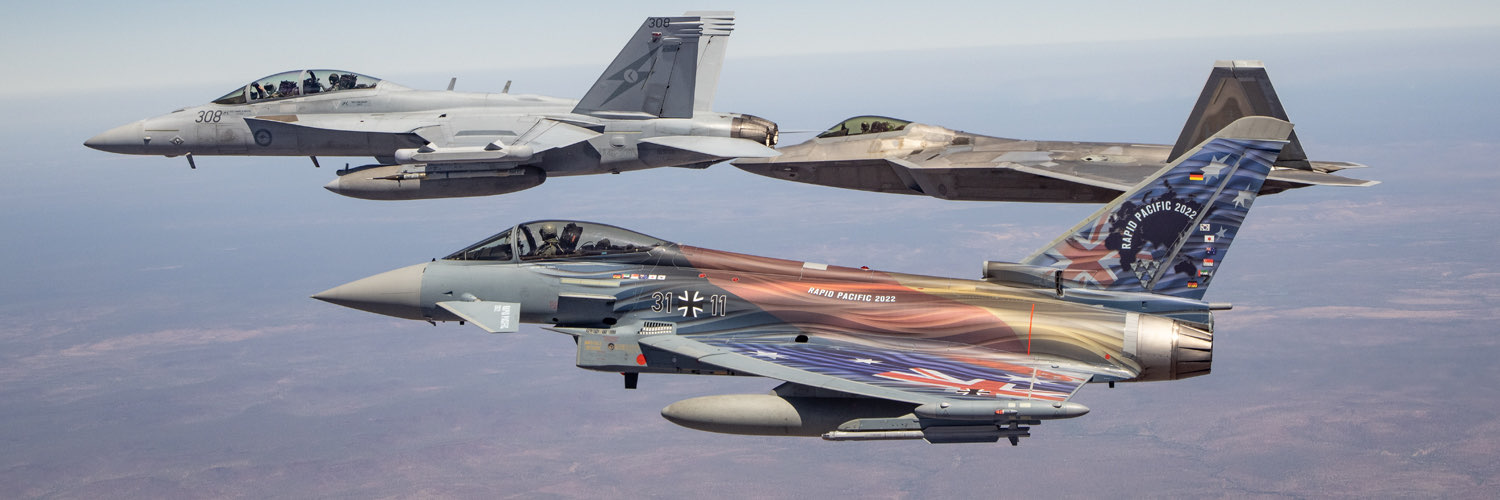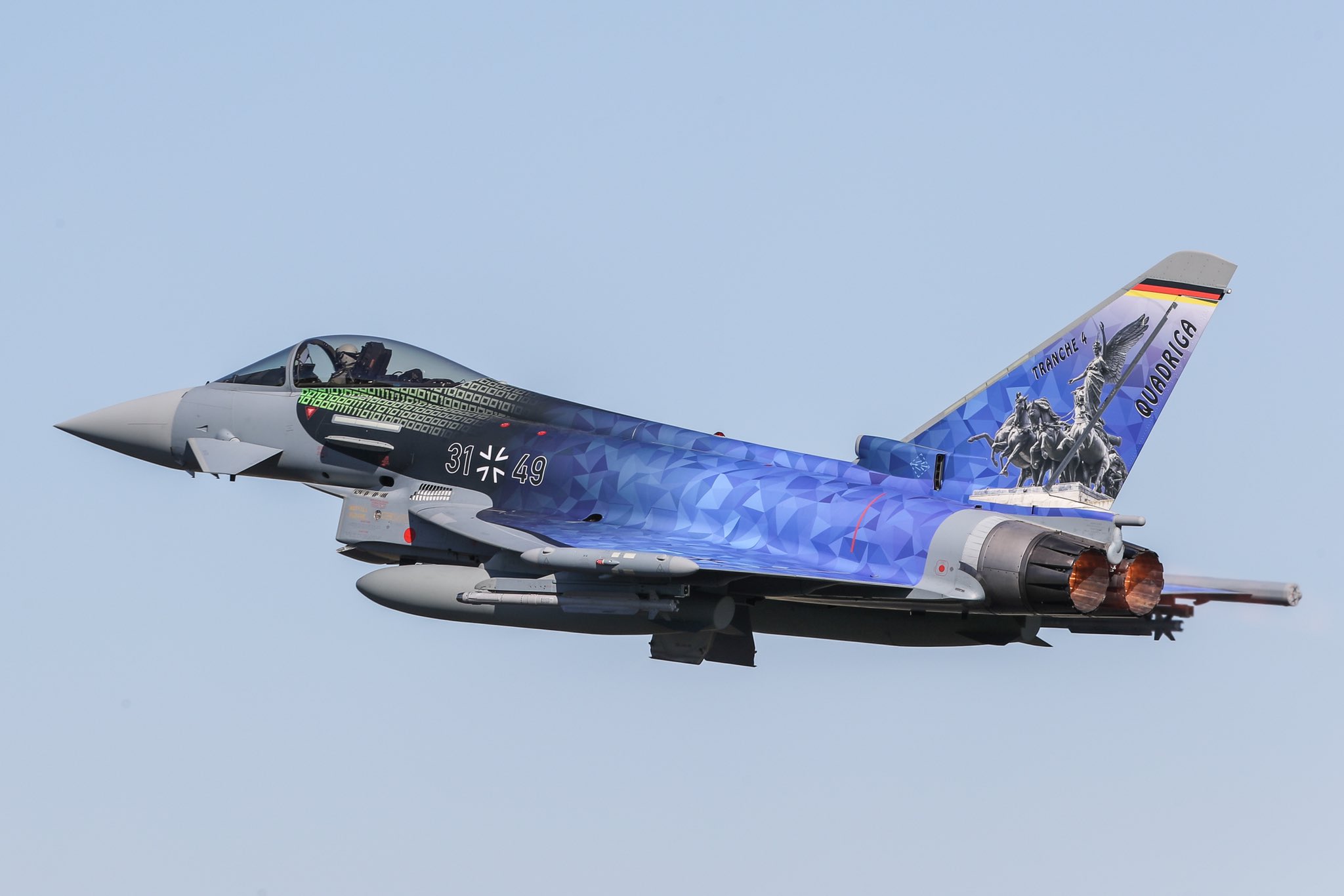America’s formidable air superiority fighter, F-22 Raptor, considered the world’s most capable jet because of its stealth features and sensor fusion technology, lost a couple of dogfights to German Eurofighter Typhoons, causing severe damage to the mighty Raptor’s reputation.
While the Raptor has lost several dogfights over the years to less advanced warplanes like the F-16 and the US Navy’s EA-18G Growler electronic-warfare fighter, losing to German Eurofighters about a decade ago was remarkable due to the traction they received.
The event in question is the US Air Force’s (USAF) large-scale Red Flag air combat exercises over Alaska in 2012. Red Flag is a two-week advanced aerial combat training exercise held several times a year by the USAF, which pits a wide variety of aircraft, often from multiple nations, against large-scale and realistic threats to replicate the circumstances of a near-peer fight.
Germany sent eight Eurofighter Typhoons from Jagdgeschwader 74, the Luftwaffe’s 74th Tactical Air Force Wing, to Eielson AFB in Alaska to participate in the exercise. The exercise included a series of within-visual-range (WVR) dogfights with the USAF’s F-22 Raptors.
Following the exercises, the German Eurofighter pilots arrived at 2012’s Farnborough International Air Show, where they quickly discussed their victories against the Raptors.
While these dogfights were simulated, German pilots took them very seriously, with one of them saying, “They had a Raptor salad for lunch.”
The F-22 Raptor Vs. Eurofighter Typhoon
The F-22 Raptor and Eurofighter Typhoon were initially designed as air superiority fighters, with the Typhoon eventually maturing into a multi-role platform. They were developed around the same time, with the Typhoon’s maiden flight in 1994, shortly followed by the F-22 in 1997.
Both fighters were ultimately introduced into the service in the early-to-mid 2000s, with the Typhoon entering active duty in 2003, shortly followed by the Raptor in 2005.

However, there is a vast difference in how these fighters actually perform their missions. The F-22 Raptor was supposed to be a revolution in air superiority, based on America’s breakthrough in stealth technology coupled with a high degree of sensor fusion and advanced avionics that provided an extreme level of situational awareness to the pilot.
Simply put, the computers onboard the F-22 allow the pilot to pay more attention to the fight and less to operate the aircraft.
“When you’re flying the Raptor, you’re not thinking about flying the Raptor,” explained F-22 pilot Randy Gordon in a lecture at MIT, “You’re thinking about employing the Raptor. Flying is secondary.”
Additionally, the F-22 also has thrust vector controls (TVC) that enable a pilot to redirect the engine’s thrust by tilting the exhaust nozzles side by side as well as up and down to perform incredibly aerobatic maneuvers during WVR combat scenarios wherein the fighter may have to maneuver nearby enemies and evade incoming missiles.
“Raptor has vector thrust: Typhoon doesn’t,” RAF Typhoon pilot and squadron commander Rich Wells said in 2013. “What the aircraft can do, it’s incredible. The Typhoon just doesn’t do that.”
So, the F-22 can see its opponent coming from afar before the opponent sees it and, therefore, destroy the enemy aircraft without its pilot knowing who hit him. At the same time, the fifth-generation aircraft also retains super maneuverable characteristics for traditional dogfighting scenarios.
According to some open sources, the F-22 is powered by two Pratt & Whitney F119-PW-100 engines, each producing a thrust of 35,000 pounds (156 kN). These engines provide a high thrust-to-weight ratio (TWR) of about 1.18.
The Eurofighter Typhoon is powered by two Eurojet EH200 afterburning turbofan engines, each providing 20,000 pounds (90kN) of thrust and delivering a higher TWR of 1.25.
Higher TWR means the aircraft is relatively light for the amount of thrust its engines produce. The Eurofighter’s superior TWR allows it to accelerate rapidly.
Furthermore, the Eurofighter also has lower ‘wing-loading’ (the ratio of aircraft weight to its wing area) than the F-22, which, coupled with its higher TWR, allows the aircraft to make tighter turns without losing speed.

To outmaneuver enemy aircraft, the fighter must be able to accelerate and turn faster, and the Eurofighter has an advantage over the F-22 in both of these factors.
Moreover, despite being a 4th-generation fighter, Typhoon has a relatively higher degree of stealth because of its design, especially the materials used in building it.
“The aircraft is built with advanced composite materials to deliver a low radar profile and strong airframe. Only 15% of the aircraft’s surface is metal, delivering stealth operation and protection from the radar-based system,” according to Eurofighter promotional materials.
Like several other fighters, including the F-22, the Typhoon also leverages electronic warfare capabilities to obscure its radar return.
The Raptor Was Neutered From The Onset!
Returning to the simulated dogfight in the Red Flag Exercise 2012, or what is referred to as Basic Fighter Maneuvers (BFMs) in fighter-pilot parlance, several details about the engagements between the F-22s and German Eurofighters in those exercises remain murky.
However, some things are known for sure. One is that some of these engagements happened in WVR, taking away F-22’s advantages in terms of stealth and sensor fusion.
In reality, the F-22 pilots would almost certainly detect the Typhoon much before the Typhoon becomes aware of the former’s presence, thereby allowing the Raptor to either take out the Typhoon from beyond visual range (BVR) or at least position itself in an advantageous position.
Furthermore, the F-22 was carrying external fuel tanks, which hindered the Raptor’s maneuverability and stealth. No pilot would dogfight for his life with external fuel tanks on his aircraft’s wings and would indeed jettison it as soon as he is challenged by a hostile aircraft or much before it is challenged.
As for the German Eurofighters, they were allowed to fly not only without fuel tanks but also without any kind of external munitions on them. This offered the German fighters much better maneuverability, and while it is possible for the Typhoon in real life to be left without any munition, but not always. The dogfight was tipped in favor of German Eurofighters from the onset.
“There were two mornings where we flew against them 1v1. We pulled off all the tanks to get the most alpha [angle of attack]; the Eurofighter is an animal with no tanks,” Germany’s Maj. Marc Gruene, one of the pilots who participated in the drills, explained.
Gruene also noted that the F-22’s thrust-vector control (TVC) impeded its performance instead of helping it when engaging with the Typhoon in close quarters.
Forget J-20, China’s H-20 Stealth Bomber Threatens ‘Easy Penetration’ Of LAC; How Can IAF Respond?
“The key is to get as close as possible to the F-22 and stay there. They didn’t expect us to turn so aggressively,” Gruene told Combat Aircraft magazine back in 2012. “As soon as you get to the merge… the Typhoon doesn’t necessarily have to fear the F-22.”
‘Merge’ refers to a very close, neutral pass made by opposing aircraft when they first meet in an air-to-air engagement, generally heading in opposite directions.
While the TVC enables a fighter to perform extreme maneuvers, these maneuvers cost the aircraft its airspeed, which is everything in a dogfight.
So, when the F-22 uses its thrust-vectoring nozzles to make sudden maneuvers, it becomes vulnerable until it can regain airspeed. If the Raptor cannot score a kill immediately after performing such a maneuver, it is easy meat for a predator until its engines can get the aircraft to move again.
Strap in and experience the raw power and thrust vectoring capabilities of the F-22 Raptor like it’s never been seen before.
📷 @SamEckholm pic.twitter.com/u0f7oDmr3D
— F-22 Demonstration Team (@F22DemoTeam) March 26, 2020
“If you are ‘defensive’ and your aircraft has Thrust Vectoring, you can outturn your enemy, but that most likely won’t prove to be a great idea: an energy fighter like the Typhoon will conveniently ‘use the vertical’ to retain energy and aggressively reposition for a missile or gunshot,” an unnamed Eurofighter test pilot explained to David Cenciotti, from The Aviationist.
“Also, the subsequent acceleration will be extremely time (and fuel) consuming, giving your opponent the opportunity to tail chase you forever, exploiting all its short-range weapon array,” the test pilot further said.
Even if the pilot is on the offensive and uses TVC to quickly point the nose of his fighter toward the enemy aircraft and scores a kill, he will become vulnerable to any other hostile aircraft nearby. This is why no other American fighter type has the TVCs.
- Contact the author at tanmaykadam700@gmail.com
- Follow EurAsian Times on Google News




